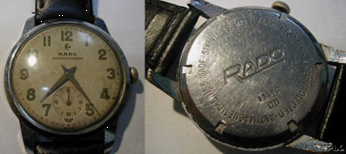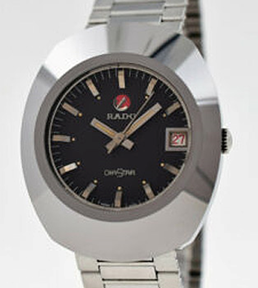By Bruce Shawkey
Found this interesting ad for Rado watches in the June 1956 issue of Europa Star magazine:


Here are previous articles I wrote about Rado:
Found this interesting ad for Rado watches in the June 1956 issue of Europa Star magazine:

Yet Rado led the way for using materials such as ceramic, hardened tungsten steel, and sapphire, that many watch collectors today expect from their high-end watches, and they have Rado to thank for it. So let’s take a look at this rather enigmatic brand.
The company that was to become popularly known as Rado was founded in 1917 as “Schlup and Co.” by three Schlup brothers, Fritz (nickname for Freidrich), Ernst and Werner, in their home town of Lengnau, Switzerland. Not much is known about the brothers (I can find no images of them) or their family. It does not appear that they came from a family of watchmakers, but rather developed an interest in watchmaking on their own. They started the business in the attic of their parents home, where it remained until 1948 when they built a modern three-story structure on the same site. The structure is seen in the photo below, and the original “factory“ is seen in the inset. This picture was probably taken
shortly after the company was came up with the Rado brand name in 1937. As you can see, the company name remained “Schlup and Co.” as seen in small letters on the company’s headquarters. The 1948 structure still stands today, though it has undergone modernization and expansion.
In those early years, Schlup & Co. produced watch movements and components for other companies who then assembled them into “private label“ watches for independent jewelers. They were “ghost“ manufacturers in the truest sense of that term. They didn’t even stamp their movements or movement parts in any way.
This was not as unusual as you might think. Certainly there were other companies that did the same thing. The Swiss watch industry had undergone a good amount of downsizing from about the mid-1800s to the early 1900s. Small firms were either absorbed by larger companies, or went out of business entirely. A movement manufacturer did anything it could to survive, and one of these tactics was making anonymous parts and movements on which others put their name.
The “Rado Watch Co. Ltd.” (pronounced RAH-doe”) was set up as a subsidiary in 1937. According to the company, “Rado” means “wheel” in Esperanto. It was chosen for its simple, melodious sound, pronounced the same throughout the world. An early example is shown at left, made for the armed forces of Germany. The brand name Exacto followed in 1940. The brand enjoyed modest success and was advertised well in the ‘50s. But the story goes the Exacto brand name ran into trademark issues in several countries, and was phased out by the late 1950s.
The Rado name began to be used for production watches in the 1950s, and enjoyed modest success, but really began to gain traction in 1957 with the release of the Green Horse collection, followed by the Golden Horse shortly
thereafter (left). Both were automatics with exceptionally good water resistance. It had a feature that would become a visual trademark, the swiveling anchor motif in a small circular depression on the dial. It was an instant hit in Asian markets where animals and colors have a particular significance. This would eventually be followed by various animal-named models in Gold, Silver, and Purple.
Rado soon distinguished itself in the crowded marketplace by developing scratch-resistant watches. While America’s workforce was already changing from blue- to white-collar, much of the work force in the rest of the world still consisted of laborers. Gold-filled watches did not wear well, and solid gold wore even worse. Even stainless steel was not
impervious to harsh treatment. And so Rado came up with a watch case that was extremely scratch resistant. Their first scratch-resistant piece was the DiaStar 1 (right), introduced in 1962, made using hardenedBut the Diaster does have a weakness. They are extremely susceptible to fingerprints, which show on this surface, and they remain. And when Rado introduced their ceramic cases in the late '80s, the fingerprint problem did not improve. Soon after the introduction of the Ceramic DiaStar, Rado even began including polishing clothes with the watches so owners could wipe them off at the end of each day — not a very practical feature of this material. But then that is way things go with most things in life. If you push one feature to an extreme, usually some other weakness emerges.
The DiaStars became very popular and, Rado came up with a whole slew of them, and usually assigned them numbers to differentiate them. The DiaStar 1 is the first, the classic saucer shape. Then came number 2, which was a round shape. The number 10 was the first square shape, and so forth. I believe they went as high as “48” and possibly higher. But the number 1 was the most popular and remains so to this day. The company claims that by 1987, they had sold 1.5 million saucer-shape DiaStars.
In 1966, Rado introduced the “Manhattan" (left). It was a symbolic event designed to underscore Rado's rather new-found popularity in America., What name could possibly be more in-your-face American as Manhattan? It was a rectangular watch, wider than it is tall. Some say “Manhattan” on the dial; some do not, and the ones that are signed Manhattan on the dial are considered more desirable.
In 1967, Rado introduced the Captain Cook, (below, right) which was the
company's first “serious” diver’s model. Most of their sport watches prior to this were water resistant, but this was the first model designed to go deeper. It was first introduced as a man‘s watch, but eventually made in a woman‘s model as well. Another diver’s model was subsequently introduced with a bright orange dial in an attempt to capitalize on the success of the Doxa SUB 300T, introduced that same year. Full color ads (printed back-to-back) appearing in Nov. 1953 Swiss Watch Journal
Full color ads (printed back-to-back) appearing in Nov. 1953 Swiss Watch JournalIn the early 1970s, Rado came out with what I personally think was their most unusual watch, which they called the “Planning.” The Planning, (left) has an extra flap attached to the bezel containing a rotating ring that houses a perpetual calendar. By means of rotating a chapter ring, you can see any given month at a glance. One of these sold for $250 in July of 2000 off the FinerTimes website. It would have been a fine investment, as I saw one offered recently on a web site for nearly 10 times that amount!
The ‘70s saw a number of case material innovations, including the Diastar 67 in 1976, which had an innovative edge-to-edge sapphire crystal (right).
In 1974, Rado introduced the DiaStar quartz model 48. But the quartz revolution put a serious damper on Rado’s production of traditional watches until the renaissance of mechanical watches occurred in the mid 1980s.
By 1983, ASUAG and SSIH merged and formed SMH, and thus put Rado under the umbrella of the world’s largest watch consortium. And, as most know, SMH eventually changed its name in 1998 to The Swatch Group.
The ‘80s also saw the brand introduce the Rado Integral, (left) the first model to use high-tech ceramics, a material which became one of its staples. The model also honed not only Rado’s now-signature material but also its distinctive minimalist design.
In the mid- to late-90s, Rado perfected the use of high-tech ceramics and pioneered two new materials: cermet, a titanium-based ceramic combined with metal, and plasma high-tech ceramics. The latter allowed for a variety of products in a range of different colors (below, right)
that have a metallic sheen, but are hypoallergenic, without any metal. A decade later, to welcome the new millennium, Rado introduced yet another fascinating watch, the The V10K (below, left), coated in the high-tech diamond making it Rado’s most scratch-resistant model at the time.
Today, Rado watches are divided into five collections: Captain Cook, True Square, True, True Thinline, and Centrix. There are multiple models within each collection. The Centrix collection is Rado’s most popular, with quartz and mechanical models available. Prices in the collection start at $1,300 and go up to $2,300 for a mechanical model with diamond dial. Most models now have ceramic cases, even the Captain Cook models, which go as high as $3,700.
While there are reported to be 191 authorized Rado dealers in the United States, Asia remains Rado’s stronghold. U.S. buyers can also buy Rado’s complete line on the company website at www.rado.com, and of course overstocks and discontinued models can be purchased on the grey market.
Here some additional Rado images:

 |
| DiaStar |
























No comments:
Post a Comment